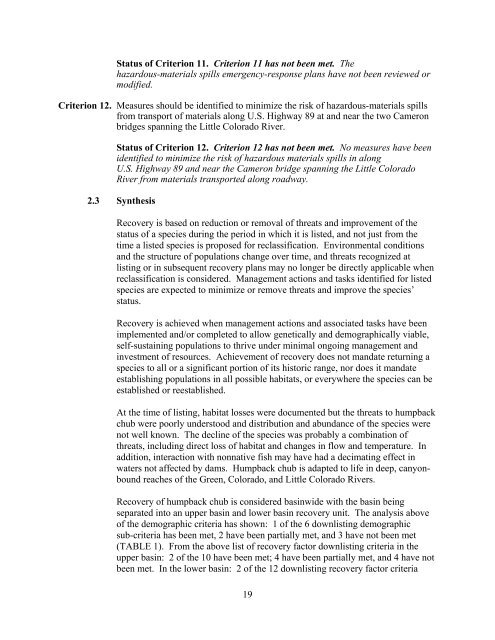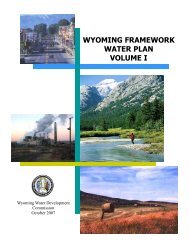Humpback chub (Gila cypha) - Upper Colorado River Endangered ...
Humpback chub (Gila cypha) - Upper Colorado River Endangered ...
Humpback chub (Gila cypha) - Upper Colorado River Endangered ...
You also want an ePaper? Increase the reach of your titles
YUMPU automatically turns print PDFs into web optimized ePapers that Google loves.
Status of Criterion 11. Criterion 11 has not been met. The<br />
hazardous-materials spills emergency-response plans have not been reviewed or<br />
modified.<br />
Criterion 12. Measures should be identified to minimize the risk of hazardous-materials spills<br />
from transport of materials along U.S. Highway 89 at and near the two Cameron<br />
bridges spanning the Little <strong>Colorado</strong> <strong>River</strong>.<br />
Status of Criterion 12. Criterion 12 has not been met. No measures have been<br />
identified to minimize the risk of hazardous materials spills in along<br />
U.S. Highway 89 and near the Cameron bridge spanning the Little <strong>Colorado</strong><br />
<strong>River</strong> from materials transported along roadway.<br />
2.3 Synthesis<br />
Recovery is based on reduction or removal of threats and improvement of the<br />
status of a species during the period in which it is listed, and not just from the<br />
time a listed species is proposed for reclassification. Environmental conditions<br />
and the structure of populations change over time, and threats recognized at<br />
listing or in subsequent recovery plans may no longer be directly applicable when<br />
reclassification is considered. Management actions and tasks identified for listed<br />
species are expected to minimize or remove threats and improve the species’<br />
status.<br />
Recovery is achieved when management actions and associated tasks have been<br />
implemented and/or completed to allow genetically and demographically viable,<br />
self-sustaining populations to thrive under minimal ongoing management and<br />
investment of resources. Achievement of recovery does not mandate returning a<br />
species to all or a significant portion of its historic range, nor does it mandate<br />
establishing populations in all possible habitats, or everywhere the species can be<br />
established or reestablished.<br />
At the time of listing, habitat losses were documented but the threats to humpback<br />
<strong>chub</strong> were poorly understood and distribution and abundance of the species were<br />
not well known. The decline of the species was probably a combination of<br />
threats, including direct loss of habitat and changes in flow and temperature. In<br />
addition, interaction with nonnative fish may have had a decimating effect in<br />
waters not affected by dams. <strong>Humpback</strong> <strong>chub</strong> is adapted to life in deep, canyonbound<br />
reaches of the Green, <strong>Colorado</strong>, and Little <strong>Colorado</strong> <strong>River</strong>s.<br />
Recovery of humpback <strong>chub</strong> is considered basinwide with the basin being<br />
separated into an upper basin and lower basin recovery unit. The analysis above<br />
of the demographic criteria has shown: 1 of the 6 downlisting demographic<br />
sub-criteria has been met, 2 have been partially met, and 3 have not been met<br />
(TABLE 1). From the above list of recovery factor downlisting criteria in the<br />
upper basin: 2 of the 10 have been met; 4 have been partially met, and 4 have not<br />
been met. In the lower basin: 2 of the 12 downlisting recovery factor criteria<br />
19
















